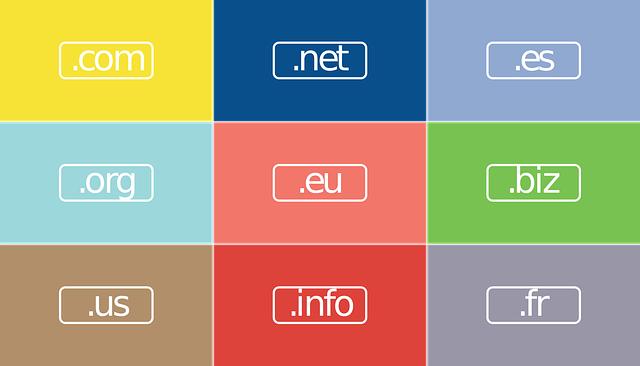Table of Contents
- Understanding the Value of Established Domains in the Digital Landscape
- Key Factors to Consider When Selecting an Existing Domain
- Strategies for Conducting Thorough Domain Research
- Maximizing Your Investment: Best Practices for Acquiring Domains
- Leveraging Existing Domains for SEO and Branding Success
- Q&A
- Key Takeaways


Understanding the Value of Established Domains in the Digital Landscape
In the competitive world of online presence, the importance of established domains cannot be overstated. Purchasing an existing domain can give a business or individual a significant head start. These domains often come equipped with existing traffic, backlinks, and a recognizable brand, translating into quicker visibility and credibility among target audiences. The intrinsic value of established domains lies in their history, which can positively influence search engine rankings and user trust.
When evaluating the potential of an established domain, consider the following factors that contribute to its value:
- Domain Age: Older domains tend to have higher authority.
- Backlink Profile: A robust network of backlinks enhances search engine ranking.
- Traffic History: Consistent organic traffic suggests stability and relevance.
- Brand Recognition: Established names can reduce marketing efforts for brand awareness.
Furthermore, analyzing the financial aspect of acquiring an established domain is key to making a wise investment. Below is a simple comparison of potential costs and benefits associated with purchasing an existing domain versus starting from scratch:
| Criteria | Established Domain | New Domain |
|---|---|---|
| Initial Investment | Higher | Lower |
| Time to Rank | Shorter | Longer |
| Traffic Potential | Immediate | Delayed |
| Reputation | Established | Unknown |
Investing in an established domain not only accelerates the growth journey but also may provide long-term benefits, making it a strategic move for those looking to make a mark in the digital landscape.


Key Factors to Consider When Selecting an Existing Domain
When choosing an existing domain, there are several critical aspects to evaluate to ensure it aligns with your brand’s goals. Domain age is one significant factor; older domains often have established authority and trust with search engines, which can positively influence your SEO efforts. Additionally, examining the domain history through tools like the Wayback Machine can provide insight into previous content and potential penalties associated with the domain.
Another essential consideration is the keyword relevance of the domain. A domain name that includes keywords related to your niche can enhance visibility in search results. However, ensure that the keywords feel natural and are not overly forced, as this can deter visitors. Also, analyze the extension of the domain (.com, .org, .net, etc.), as certain extensions can carry specific connotations and trust levels that may impact user perception.
assessing the backlink profile is crucial. A domain with a robust and reputable backlink profile can provide significant SEO benefits. Tools like Ahrefs or SEMrush can help evaluate the quality of backlinks and identify any potentially harmful links that could affect your SEO standing. Make sure to consider the target audience and demographics associated with the domain to ensure it aligns with your strategic goals and branding.
Strategies for Conducting Thorough Domain Research
To ensure you make informed decisions when purchasing an existing domain, it’s crucial to dive deep into the details surrounding it. Start by analyzing the domain’s history to uncover any potential red flags. Utilize tools like Wayback Machine or DomainTools to explore how the site was used previously. Understanding its past will help you gauge if it has a positive reputation or if it might have been involved in dubious activities that could affect your plans.
Next, it’s important to assess the domain’s current SEO standing. Utilize tools like SEMrush or Ahrefs to obtain vital metrics, such as domain authority, backlink profiles, and organic traffic data. Review the following factors to evaluate the SEO health of the domain:
- Domain Authority (DA): A score that predicts how well the domain will rank on search engines.
- Backlink Quality: Check for high-quality backlinks that contribute to the domain’s authority.
- Keyword Rankings: See which keywords the domain currently ranks for and their search volumes.
Lastly, don’t overlook the significance of a domain’s market value. This involves not only understanding what the domain is worth based on its keywords, age, and competition but also considering its branding potential. Create a valuation sheet that includes aspects like:
| Criteria | Value |
|---|---|
| Age of Domain | 5 years |
| Keyword Relevance | High |
| Past Traffic | 10,000 visitors/month |
By incorporating these strategies into your research, you will be well-equipped to make an educated decision about which existing domain suits your needs best.


Maximizing Your Investment: Best Practices for Acquiring Domains
When venturing into acquiring domains, understanding their inherent value is crucial. It’s not just about the price tag; rather, consider elements like the domain’s age, previous traffic, and its backlink profile. This information can help you gauge how much influence and equity the domain already possesses. To assess these factors, tools like Ahrefs and SEMrush can provide insights into SEO metrics, while domain appraisal services can give you an estimate of the market value. It’s essential to conduct thorough due diligence before making any purchase.
In addition to assessing value, targeting your niche is another smart strategy. Select domains that resonate with your business goals and sector. Think about specific keywords that not only describe your offerings but also attract your target audience. A well-chosen domain can enhance branding efforts and improve search engine visibility. Crafting a compelling domain name that reflects your brand identity while incorporating relevant keywords will greatly benefit your online presence. Offerings include:
- Short and memorable names
- Keywords relevant to your industry
- Avoiding hyphens and numbers for clarity
consider the negotiation tactics that can facilitate a successful domain acquisition process. Many domains are owned by individuals or companies willing to negotiate. Conduct research to gain insights into the seller’s motivation and be prepared to make an offer that reflects the value identified in your earlier assessments. Establish rapport with the seller for a smoother negotiation experience, and don’t hesitate to walk away if the terms don’t meet your criteria. A simple process flow to illustrate your target acquisition approach could look like this:
| Step | Description |
|---|---|
| Research | Analyze domain metrics and background |
| Identify Criteria | Determine ideal keywords and relevance |
| Negotiate | Engage the seller and present your offer |


Leveraging Existing Domains for SEO and Branding Success
Investing in an established domain can significantly boost your website’s SEO rankings and enhance your brand visibility. Existing domains often come with inherent advantages such as existing backlinks, organic traffic, and brand recognition. By integrating these domains into your strategy, you can leverage their established authority while also saving time on building credibility from scratch. This can be especially beneficial for new businesses looking to enter competitive markets.
Here are some key benefits to consider when exploring existing domains:
- Backlink Profile: Existing domains may already have a robust backlink profile, improving your site’s trust and authority.
- Keyword Relevance: Acquiring a domain with relevant keywords can enhance your SEO efforts, allowing you to rank for terms that matter from the outset.
- Brand Recall: Established domains may already possess brand recognition, making it easier to direct traffic and foster trust with users.
- Reduced Time for Ranking: With a mature domain, you are likely to see results in your search engine rankings more quickly than with a new domain.
When evaluating potential domains, it’s crucial to conduct thorough research to ensure they align with your business goals. Consider factors such as the domain’s previous content, traffic metrics, and any potential penalties linked to it. Collaborating with SEO experts can help you assess these domains for their viability. To streamline this process, you might find the following table helpful in comparing key metrics of your shortlisted options:
| Domain Name | DA (Domain Authority) | Traffic (Monthly) | Backlinks |
|---|---|---|---|
| exampleone.com | 50 | 2000 | 150 |
| exampletwo.com | 45 | 1500 | 125 |
| examplethree.com | 55 | 3000 | 200 |
Q&A
Q&A: Buying Existing Domains
Q1: What are existing domains, and why should I consider buying one? A1: Existing domains are websites that have been registered by someone else but are now available for purchase. Buying an existing domain can save you time, as it often comes with established backlinks, traffic, and brand recognition. This means you can hit the ground running rather than starting from scratch.Q2: How can I find existing domains for sale? A2: There are several ways to find existing domains. You can use online marketplaces such as Sedo, Flippa, or GoDaddy Auctions. Additionally, domain brokers can help you locate premium domains that are not publicly listed. Networking with other domain investors can also lead to private sales.
Q3: What factors should I consider when evaluating an existing domain? A3: When evaluating a domain, consider its age, traffic history, SEO value, and keyword relevance. Check if it has a clean backlink profile and no history of penalties from search engines. The domain extension (.com, .net, etc.) can also affect its value. Short, memorable names with relevant keywords typically command a higher price.
Q4: Are there risks involved in buying existing domains? A4: Yes, there are some risks to consider. The domain may have a history that could negatively impact your SEO, or it may not have as much traffic as advertised. Additionally, if the previous owner had a poor reputation or was involved in spammy practices, this could affect your brand’s credibility. Always conduct thorough due diligence before making a purchase.
Q5: What is the best way to negotiate a price for an existing domain? A5: When negotiating for an existing domain, start by researching similar sales to understand its market value. Approach the seller with an offer that’s respectful of the domain’s worth. Engage in an open dialogue, expressing your interest and willingness to find a mutually beneficial price. Patience and flexibility can often lead to better deals.
Q6: How do I transfer ownership of an existing domain once I purchase it? A6: After completing the purchase, the transfer process usually involves the seller unlocking the domain and providing you with an authorization code. You then initiate the transfer with your domain registrar, following their specific guidelines. This process is typically straightforward but can take several days to complete.
Q7: What can I do with an existing domain once I own it? A7: Once you own an existing domain, the possibilities are vast. You can build a brand around it, redirect it to an existing website, or even develop it into a full-fledged business. Consider your goals and how the domain aligns with your vision, as this will guide your next steps effectively.
Q8: Is it worth consulting with experts when buying an existing domain? A8: Yes, consulting with experts such as domain brokers or SEO professionals can be invaluable. They can provide insights into the domain’s past performance, authentic traffic stats, and potential for future growth. Their expertise can help you avoid costly pitfalls and make a more informed decision.
Embarking on the journey to buy an existing domain can be both exciting and beneficial for your online presence. With the right research and strategy, you can discover a domain that aligns perfectly with your goals and vision.

